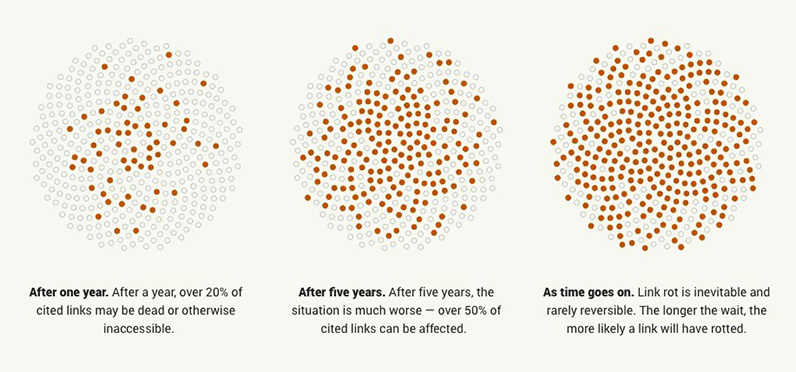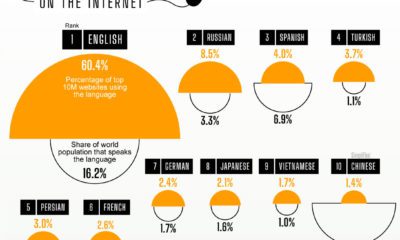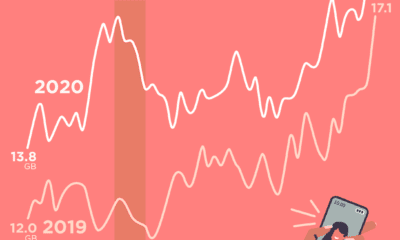Alex Tew launched the The Million Dollar Homepage, where anyone could “own a piece of internet history” by purchasing pixels-plots (minimum of 10×10) on a massive digital canvas. At the price of just one dollar per pixel, everyone from individual internet users to well-known companies like Yahoo! raced to claim a space on the giant digital canvas.
Today, The Million Dollar Homepage lives on as a perfect record of that wacky time in internet history – or so it seems. However, the reality is that many of the hyperlinks on the canvas are now redirects that send incoming users to other sites, while over 20% of them are simply dead. Here are the links that still work on the Million Dollar Homepage today:
The revealing graphic above, via John Bowers, raises the question – how do hyperlinks disappear, and what implications does this “digital decay” have?
Digital Decay
The internet is stitched together by an incalculable number of hyperlinks, but much like cells in an organism, the sources and destinations have a finite lifespan. Essentially, links can and do die.
Most “link rot” is the result of website restructuring, or entities going out of business and pulling their website offline. A high-impact example of this is when Yahoo! pulled the plug on GeoCities, one of the first popular web hosting services. In one fell swoop, roughly 7 million websites (containing a plethora of animated gifs, auto-playing midi files, and traffic counters) went dark forever. Links can also die because of more deliberate reasons, as well. In 2015, the editor-in-chief of Buzzfeed, Ben Smith, came under fire for deleting thousands of posts from the site (including content that was critical of Buzzfeed advertisers). Journalism has traditionally acted as a public record, so this type of “decay” has serious implications on the credibility of media brands.
Who Cares?
This idea of a public record is at the heart of why digital decay is an issue worth addressing. Once millions of links simply burn out, what will people in the future know about society in the early-ish days of the internet? What record will remain of people’s thoughts and feelings in that era? – Vint Cerf, Internet pioneer Perhaps more urgent are public records that live in the digital realm. Supreme Court decisions and academia lean heavily on citations to build their arguments. What happens when those citations simply vanish? A Harvard study found that 49% of the hyperlinks in Supreme Court decisions are now broken. Even that ubiquitous resource, Wikipedia, has serious issues caused by digital decay. Over 130,000 entries link to dead pages – a troubling development, as linked citations are what lend entries their credibility.
Backing Up The Internet
A handful of people are taking steps to archive the internet. The most well-known solution is Internet Archive’s Wayback Machine, which has archived hundreds of billions webpages over the past 20 years. Even the The Library of Congress – which is well known for archiving digital information such as tweets – contracts Internet Archive to do its web crawling. The academia-focused Perma is another example of a company looking to create permanent records of the web sources (particularly citations). Many of the weird and wonderful forums and hand-coded homepages of early internet lore may be gone, but we’re finally taking steps to combat digital decay. As awareness grows, avoiding an “informational black hole” may be possible.
on But fast forward to the end of last week, and SVB was shuttered by regulators after a panic-induced bank run. So, how exactly did this happen? We dig in below.
Road to a Bank Run
SVB and its customers generally thrived during the low interest rate era, but as rates rose, SVB found itself more exposed to risk than a typical bank. Even so, at the end of 2022, the bank’s balance sheet showed no cause for alarm.
As well, the bank was viewed positively in a number of places. Most Wall Street analyst ratings were overwhelmingly positive on the bank’s stock, and Forbes had just added the bank to its Financial All-Stars list. Outward signs of trouble emerged on Wednesday, March 8th, when SVB surprised investors with news that the bank needed to raise more than $2 billion to shore up its balance sheet. The reaction from prominent venture capitalists was not positive, with Coatue Management, Union Square Ventures, and Peter Thiel’s Founders Fund moving to limit exposure to the 40-year-old bank. The influence of these firms is believed to have added fuel to the fire, and a bank run ensued. Also influencing decision making was the fact that SVB had the highest percentage of uninsured domestic deposits of all big banks. These totaled nearly $152 billion, or about 97% of all deposits. By the end of the day, customers had tried to withdraw $42 billion in deposits.
What Triggered the SVB Collapse?
While the collapse of SVB took place over the course of 44 hours, its roots trace back to the early pandemic years. In 2021, U.S. venture capital-backed companies raised a record $330 billion—double the amount seen in 2020. At the time, interest rates were at rock-bottom levels to help buoy the economy. Matt Levine sums up the situation well: “When interest rates are low everywhere, a dollar in 20 years is about as good as a dollar today, so a startup whose business model is “we will lose money for a decade building artificial intelligence, and then rake in lots of money in the far future” sounds pretty good. When interest rates are higher, a dollar today is better than a dollar tomorrow, so investors want cash flows. When interest rates were low for a long time, and suddenly become high, all the money that was rushing to your customers is suddenly cut off.” Source: Pitchbook Why is this important? During this time, SVB received billions of dollars from these venture-backed clients. In one year alone, their deposits increased 100%. They took these funds and invested them in longer-term bonds. As a result, this created a dangerous trap as the company expected rates would remain low. During this time, SVB invested in bonds at the top of the market. As interest rates rose higher and bond prices declined, SVB started taking major losses on their long-term bond holdings.
Losses Fueling a Liquidity Crunch
When SVB reported its fourth quarter results in early 2023, Moody’s Investor Service, a credit rating agency took notice. In early March, it said that SVB was at high risk for a downgrade due to its significant unrealized losses. In response, SVB looked to sell $2 billion of its investments at a loss to help boost liquidity for its struggling balance sheet. Soon, more hedge funds and venture investors realized SVB could be on thin ice. Depositors withdrew funds in droves, spurring a liquidity squeeze and prompting California regulators and the FDIC to step in and shut down the bank.
What Happens Now?
While much of SVB’s activity was focused on the tech sector, the bank’s shocking collapse has rattled a financial sector that is already on edge.
The four biggest U.S. banks lost a combined $52 billion the day before the SVB collapse. On Friday, other banking stocks saw double-digit drops, including Signature Bank (-23%), First Republic (-15%), and Silvergate Capital (-11%).
Source: Morningstar Direct. *Represents March 9 data, trading halted on March 10.
When the dust settles, it’s hard to predict the ripple effects that will emerge from this dramatic event. For investors, the Secretary of the Treasury Janet Yellen announced confidence in the banking system remaining resilient, noting that regulators have the proper tools in response to the issue.
But others have seen trouble brewing as far back as 2020 (or earlier) when commercial banking assets were skyrocketing and banks were buying bonds when rates were low.



















